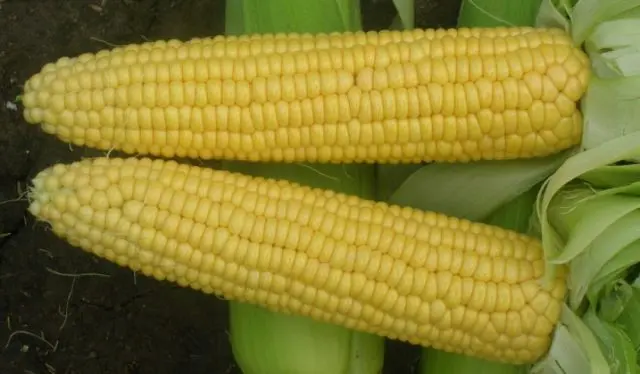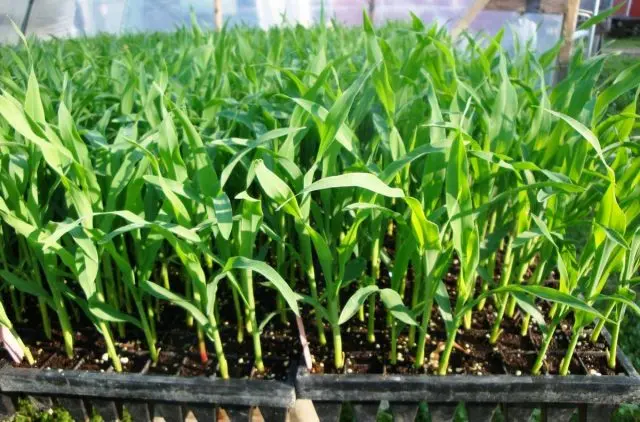Contents
Sweet corn Trophy F1 is a high-yielding variety. The cobs of this crop ripen about the same size, have an attractive appearance, the grains are pleasant in taste and very juicy. Trophy sweet corn is actively used for cooking and preservation.
Characteristics of the Trophy F1 corn variety

Trophy is a productive sweet corn hybrid from a Dutch producer. This variety shows resistance to major diseases, as well as to lodging and drought. The plant can grow up to two meters in height. Trophy F1 has strong stems that do not have as many leaves as compared to other corn varieties. Grains of a variety of golden color, large in width, but slightly shortened in length. A distinctive feature of Trophy is the presence of a sweet aftertaste. The average length of cobs is about 20 cm.

To grow Trophy corn, you need a field that is large enough. The most successful cobs have the following characteristics:
- The approximate number of rows of grains is 18 pieces;
- The length of one cob is approximately 20 cm. The diameter is 4 cm;
- The color of the grains is bright yellow: this color is typical for sweet corn species;
- The weight of one cob is about 200 – 230 grams.
The advantage of the hybrid is that Trophy corn can be grown both for sale and for personal use. Grain is well stored in winter time. The maturation period for Trophy corn is approximately 75 days. The plant has an early ripening period.
Rules for growing corn Trophy F1
To get a good crop of cereal crops, it must be planted on porous soils. In addition, the beds in the field should be placed in such a way that the plants are protected from the winds.
This variety of cereal does not tolerate stagnant water. This happens because the plant has long and powerful roots that can penetrate to a depth of two and a half meters. Such a strong root system has the advantage of growing in dry times. It is quite convenient to process the soil around the plant, since its roots quickly deepen.
Before proceeding with the planting of cereals, it is necessary to prepare the soil. This is best done during the autumn plowing period. It is recommended to use the following calculation: for one square meter of the field, about four kilograms of compost or humus are required, as well as 30 grams of superphosphate and 25 grams of potassium salt.
Trophy variety requires heat, especially during the formation of grains. It is for this reason that early ripe varieties are grown in seedlings.

Mid-season varieties should be planted in soil that is already well warmed by the sun. The best period for this will be mid-May. Thus, the harvest can be harvested at the end of summer. In addition, this way you can prolong the fruiting of corn beds.
Usually compost varieties are arranged according to the scheme of 70x25x30 centimeters. It makes sense to plant tall ones a little wider in a row, namely: according to the scheme of 70×40 centimeters.
In the case of the seedling method, it is not recommended to use seedlings older than 30 days, as they have dry roots, which leads to poor plant growth.
How to grow seedlings:
- First you need to prepare nutritious soil. To do this, the soil must be mixed with humus or compost in a ratio of 1×1;
- The mixture is distributed in cups or pots. You can also use special cassettes;
- Trophy corn seeds are buried to a depth of 3 centimeters. Then they are watered;
- Seedlings are left in a bright place. In this case, the temperature in the room should be 18 – 22 ° C. Plants should be watered once a week;
- 10 days before planting, it is necessary to fertilize the seedlings with Crystalon or other nitrogen-containing fertilizers. During this period, seedlings can already be taken out into the street: this will contribute to its gradual hardening.
Seedlings should be plentifully watered and fertilized. You should also prevent the appearance of a crust on the ground, as this will make it difficult for the grains to germinate.
The seedless method involves planting germinated seeds in heated soil. Grains are placed in one hole in the amount of 3-4 pieces and to a depth of 5-7 centimeters. In dry weather, crops should be watered and mulched.
Trophy F1 corn care
Care of the beds when growing Trophy corn is as follows:
- A few days after sowing, it is necessary to harrow the soil. This will destroy the crust of the earth and destroy the seedlings of weeds.
- If the ground temperature drops, you should think about protecting the seedlings. To do this, the beds can be covered with a special agrofiber or foam.
- As soon as the plants begin to grow, the soil should be loosened after each rain. Row spacing must be processed to a depth of 8 centimeters. This will improve the access of moisture and air to the roots of plants.
- When the plants show the first two or three leaves, they must be broken through, leaving the strongest seedlings.
- During this period, the roots of plants are not too developed, so they cannot absorb enough nutrients. To fix this, you need to apply top dressing. Suitable complex or organic fertilizers. They should be used in liquid form and poured to a depth of about 10 centimeters.Important! Plants can also be fed with bird droppings. To do this, it must be diluted in water, observing a ratio of 1:20, and add 15 grams of potassium salt and 40 grams of superphosphate. The specified ratio is calculated for 10 liters of solution.
- During the period of throwing panicles, plants are in great need of moisture. In the summer they need to be watered several times with the calculation of 3 – 4 liters per square meter.
- To increase the yield and resistance to lodging, it is necessary to hill the bushes to a height of 8 – 10 centimeters.
- During the period when 7-8 leaves appear on the main stem, stepchildren grow. These are side shoots that help weaken the plant. It is necessary to break out the processes when they reach a size of 20 – 22 cm in length. Such a technique can increase the yield of Trophy corn by 15%.

When the cobs reach milky ripeness, they must be harvested. This period occurs approximately 18 – 25 days after the appearance of flowering.
Signs that determine the readiness of harvesting Trophy corn:
- The edge of a few millimeters on the cob wrapper begins to dry out;
- The threads at the top become brown;
- The grain becomes even, full, wrinkled folds disappear on it;
- If you press a grain of corn with your fingernail, the juice will appear on it.
Reviews about corn Trophy F1
Conclusion
Trophy corn is a very high quality, tasty and aesthetically pleasing cereal. Plants bring a good harvest, and the cobs are large and even. It is better to grow Trophy corn with the help of seedlings.









